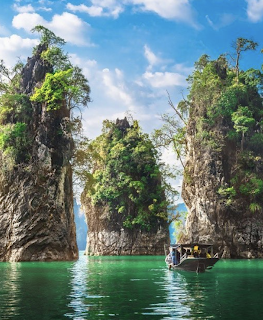Published on February 22, 2018

Tourists relaxing in Bangkok, Thailand. Image courtesy of igorovsyannykov/Creative Commons
Be prepared for anything: Southeast Asia might throw any combination of unpredictable situations at the traveler, including (but not limited to) typhoons, searing hot sunlight, humidity, and mosquitoes.
Our blogger friends have plenty of experience traveling to Southeast Asia, and know what to pack for any eventuality; they’ve been kind enough to provide us with advice for what to bring the next time you head on over.
Moisture-wicking, flowing clothing
For most of lowland Southeast Asia, its proximity to the equator means that humidity is a persistent reality for travelers. And that can be uncomfortable, to say the least.
“For Western visitors, the combination of temperature and humidity in Asia can be overwhelming, even though you think you may have prepared with the appropriate wardrobe pieces,” explains Betsy Wuebker of PassingThru Enterprises (Twitter|Facebook|Instagram). “The biggest surprise for us was how uncomfortable we were in our 100% cotton clothing!”
As cotton readily absorbs and holds on to moisture, cotton T-shirts can easily turn damp and clammy, turning your vacation into a nightmare. (Singapore takes care of this by installing air conditioning in every imaginable indoor space, from Marina Bay to its ubiquitous malls; other countries in Southeast Asia aren’t so lucky.)
Betsy suggests choosing moisture-wicking natural linen, rayon and blends, instead. For added ventilation, “try to stay away from tightly fitted silhouettes and go for loose and flowing cuts,” Betsy suggests – perfect for exploring Bangkok and walking through the Isaan countryside alike. “Skirts and dresses are going to feel much cooler than tight shorts and pants.” The locals, with their sarong and long skirts, knew what they were doing.

Tourists in Pura Besakih, Bali, Indonesia. Image courtesy of mattjlc/Creative Commons
Emergency temple attire
“Southeast Asia is rich in cultural and religious heritage, and there are many temples and mosques to explore in every city and town,” explains Gary Low of 2 Week Trips (Instagram|Twitter|Pinterest). From Brunei’s gorgeously-lit mosques to Buddhist temples in Myanmar, almost every country has a historic place of worship that demands a higher level of attire than your usual sleeveless shirt and shorts.
“As many of these places are still visited by locals to pray and seek blessings, you may be required to wear a sarong when entering the compound. And wearing pants when walking in the sweltering tropical heat of Southeast Asia gets uncomfortable quickly, so pack along your favourite sarong and you’ll never be left out in the courtyard – literally!”
If you don’t feel confident enough to rock a sarong, Vicki Viaja (Facebook|Instagram) suggests bringing a kimono instead, which has the added benefit of covering up shoulders and arms. Plus, “They don’t take up much space and you can easily bring them in your backpack with you on a daily basis,” Vicki says. “So, when you want to visit a temple, you just need to put it on and you are ready to go.”
Either way, you “not only save some money as you don’t have to rent clothes, but also you show respect to the locals and religious visitors of the temple,” Vicki says. “Moreover, they don’t make you sweat as much as normal jackets would as they are light and often permeable to air.”

Tourists under umbrellas in Indonesia. Image courtesy of Seth Mazow/Creative Commons.
Umbrellas & waterproof bags
The humble umbrella works double time in Southeast Asia – repelling both rainshowers and rays.
“There can be unpredictable showers due to the rise in humidity in the air; and sometimes, the sun is too harsh and while the locals are accustomed to it, many visitors aren’t!” says Lavina D’Souza of Continent Hop. “It’s always best to carry an umbrella.”
Lavinia suggests bringing a compact umbrella that can be easily brought in one’s luggage and carried around. “It’s always best to carry one that can easily fold into something really compact and light,” she explains. “Also, if the umbrella does not come with a cover, carry one or carry a compact plastic bag so that instead of carrying a wet umbrella around you can put it in the plastic bag and then put the bag in your backpack/handbag!”
Umbrellas won’t protect your luggage from getting soaked through in the rain – and for that, Lola Méndez of Miss Filatelista (Facebook|Twitter|Instagram) suggests bringing a waterproof bag to keep your essentials dry.
“I’ve traveled to eight Southeast Asian countries and the one thing I am always glad that I have in my bag is my Wander Wet Bag,” Lola says. “The coating doesn’t allow anything to leak into your bag which is just brilliant!”
Through her travels, the waterproof bag has kept her dry clothes separated from a soaking swimsuit; organized swimwear and linterie; and stored dirty clothes while in transit. “The possible uses for these bags really go on and on,” Lola enthuses. “My bag has a darling yellow starfish pattern so I often use it as a clutch purse, too!”

Mosquito net in Riau, Indonesia. Image courtesy of David Jones/Creative Commons.
Anti-Mosquito Stuff
Mosquitoes are a pesky, occasionally deadly, nuisance: dengue fever sickens and kills hundreds in Southeast Asia every year. Thus, “packing an effective repellent or mosquito spray when traveling to certain destinations within SE Asia should be as basic as carrying your toothbrush with you,” suggests Inma Gregorio of A World to Travel.
Inma’s packing list of essentials alway includes an insect repellent with DEET. “I never fail to carry it with me – they are supposedly pretty good keeping mosquitos away and they last longer hours on your skin,” she says. “It will really make your life much easier in some tricky spots (if you are near water) and at certain hours (mostly around sunset).”
If you’re concerned about harmful DEET interactions, Constance Panda of the Adventures of a Panda Bear (Instagram|Facebook) suggests looking into DEET-free bug sprays, which “usually contain a variety of plant-based oils that naturally repel bugs, such as citronella, peppermint, and lemongrass.”
A spray-less form consists of an oil-impregnated rubber mosquito repellent bracelet – “they usually last for multiple days, I’ve used some that lasted as long as 10 days!” Constance explains. “The bracelets can have an intense oil aroma; some people prefer to wear the bracelets on their ankles.”
For a very unfortunate few, sprays or bands don’t work at all: “For some of us, mosquitos love the taste of our blood like a fat kid loves cake,” complains Ellie Hattersley of Grad Gone Global. “On my recent trip to Indonesia, I took the initiative and brought my own mosquito net – and it was a total life saver. An inexpensive purchase in advance, it saved me so many hours of itching!”
Ellie prefers the bottom bunks of dorm beds for setting up mosquito nets: “Just hook it up to any available protruding edges, or tuck it into the slats of the bed above, and voila! The best kind of nets are the ones pre-treated with mozzie repellent for extra protection, just in case they fall down in the night.”






